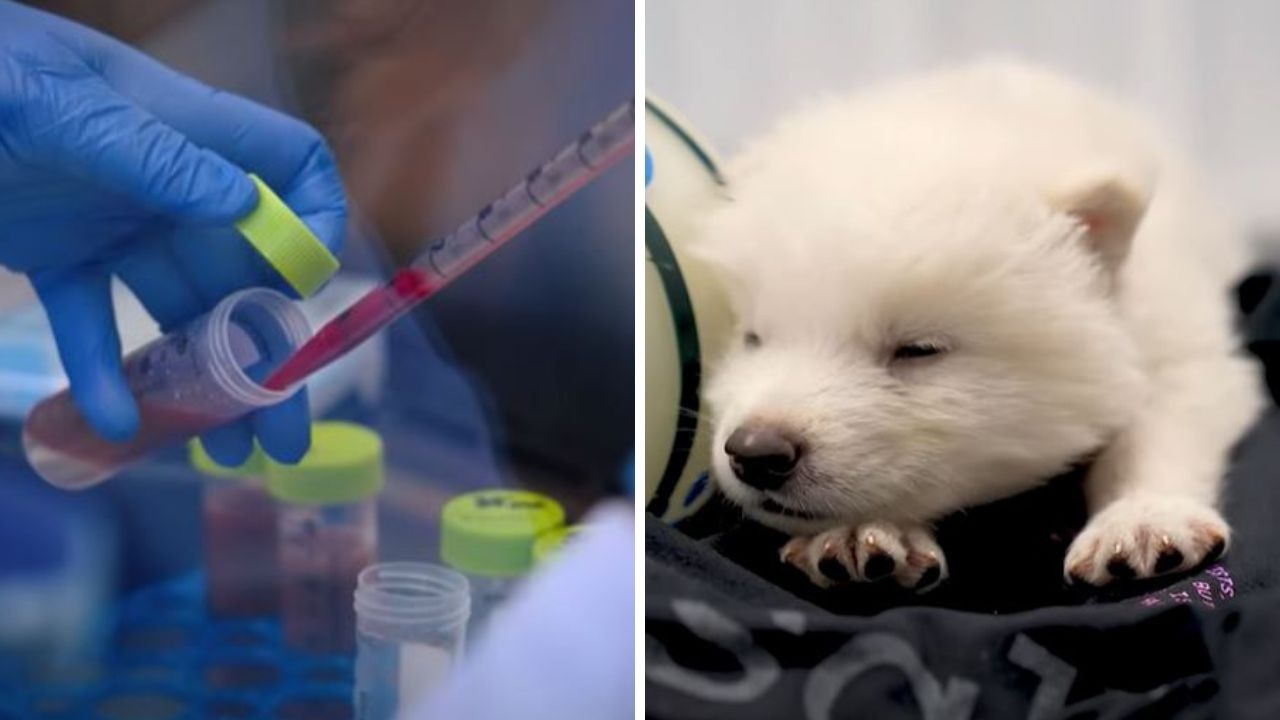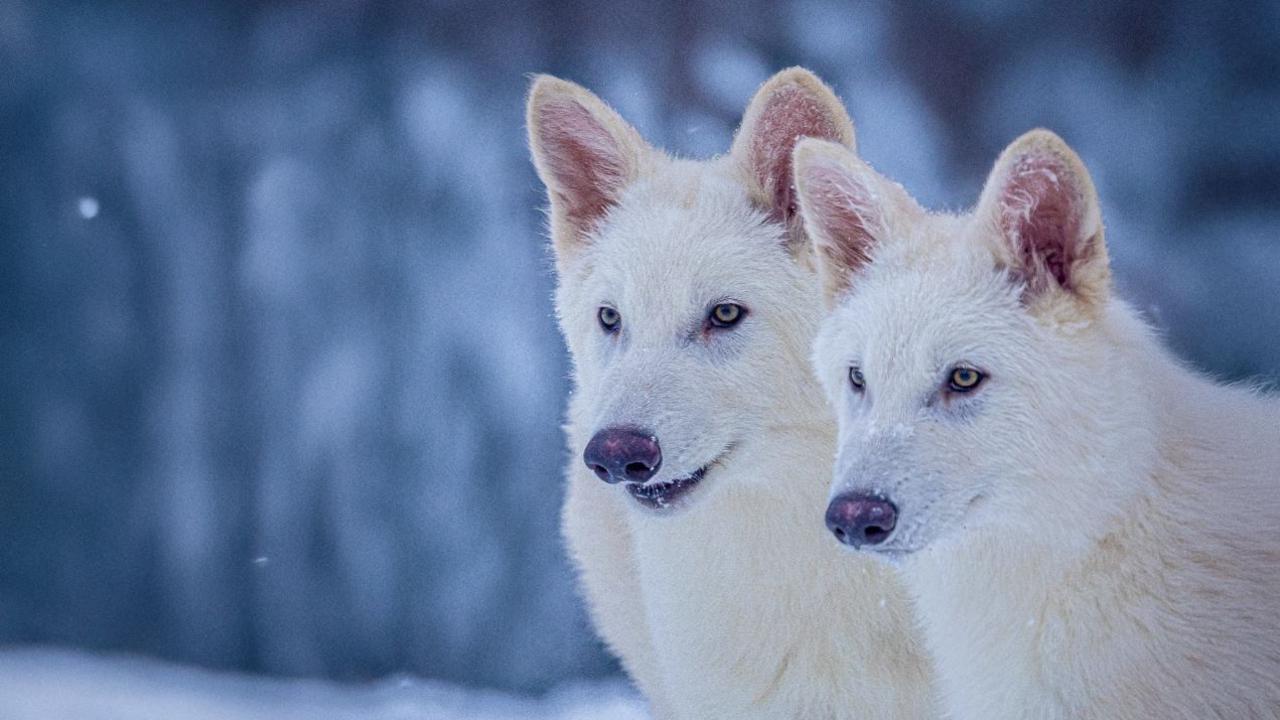Pups cloned using dire wolf DNA hailed a ‘de-extinction’ success
Science and literature have seen a remarkable breakthrough that could revive vanished species, after DNA from a 13,000-year-old extinct wolf made famous in fiction was crossbred back to life

READING LEVEL: ORANGE
The dire wolf — a species that disappeared 13,000 years ago and was made famous by the hit series Game of Thrones — is making a comeback of sorts, thanks to the first-ever so-called “de-extinction*.”
Three crossbreed wolf pups — Khaleesi*, Romulus and Remus* — were successfully born using DNA from ancient dire wolf fossils together with genes from their closest living relative, the grey wolf.
The extraordinary results were revealed Monday by Colossal* Biosciences, the same Texas-based genetic engineering* company that created the adorable colossal woolly mouse, a cross-species genetic edit between woolly mammoth DNA and that of mice. The company has claimed the wolf pups are another howling success in its wider "de-extinction" project.
“Our team took DNA from a 13,000-year-old tooth and a 72,000-year-old skull and made healthy 'dire wolf' puppies,” said Colossal CEO Ben Lamm. “It was once said, ‘any sufficiently advanced technology is indistinguishable from magic.’ Today, our team gets to unveil some of the magic they are working on and its broader impact on conservation*.”
To create the ridiculously cute pups, Colossal cloned* high-quality cell lines using somatic cell* nuclear transfer into donor egg cells, and transferred them to a surrogate* dog mum, who gave birth in January, according to the statement.


The ancient DNA was taken from a tooth fossil found in Ohio that is around 13,000 years old and an inner ear bone from Idaho, about 72,000 years old.
The two six-month-old male wolves, Romulus and Remus, and female pup Khaleesi now live on an 800 hectare “secure expansive ecological* preserve” with 10 full-time staff to give them around-the-clock care, Colossal said.
Fictional dire wolves have appeared as animal characters in HBO’s Game of Thrones and George R.R. Martin’s series of fantasy novels on which the TV show is based, A Song of Ice and Fire.
In the show, the wolves are the sigil, or mascot, of House Stark.
Khaleesi was also named after the character, Daenerys Targaryen, played by Emilia Clarke in the series.
Despite their fictional significance, dire wolves were real-world predators* that lurked across North America with mastodons* and sabre tooth tigers during the Ice Age. They hunted horses, bison and possibly mammoths, palaeontologist* Julie Meachen told the New York Times.


After much of their prey became extinct due to human hunters, the dire wolf followed, and the grey wolf filled the “ecological void,” Ms Meachen said.
Dire wolves were 25 per cent larger than their grey wolf counterparts*, with more muscular jaws and shoulders, biologists said.
Lamm and George Church, a Harvard Medical School biologist, founded the now $10 billion private company with the goal of bringing back the woolly mammoth, Bloomberg reported.
The company also has its eyes set on reviving the Tasmanian tiger, the dodo*, and it successfully genetically engineered the woolly mouse only last month, which shares similar curly-haired features with woolly mammoths.

“The 'de-extinction' of the dire wolf and an end-to-end system for de-extinction is transformative and heralds an entirely new era of human stewardship* of life,” Colossal scientific adviser Dr Christopher Mason said in the statement.
“This is an extraordinary technological leap in genetic engineering efforts for both science and for conservation, as well as preservation of life, and a wonderful example of the power of biotechnology to protect species.”
This story has been updated and edited. It first appeared in the New York Post and was republished with permission.
WATCH THE VIDEO
POLL
GLOSSARY
- de-extinction: the process of resurrecting species that have died out or gone extinct
- Romulus and Remus: in Roman mythology, the twin brothers founded Rome after being raised by a she-wolf
- Khaleesi: a term meaning “queen” Dothraki, a fictional language invented by author George R.R. Martin for his fantasy series A Song of Ice and Fire
- colossal: huge, massive, enormous
- genetic engineering: scientific process using laboratory-based technologies to alter the DNA makeup of an organism
- conservation: preserving and protecting something
- surrogate: substitute, replacement, a female human or animal that births a baby that is not their own
- cloned: generated a genetically identical copy of a cell or an organism
- somatic cell: all the cells of the body except the reproductive cells
- ecological: relating to ecology, the study of all living things and their environment
- predators: animals that naturally hunt, kill and eat other animals in order to survive
- mastodons: a large animal similar to an elephant, but with fur, that existed until around 10,000 years ago
- palaeontologist: someone who studies fossils to get information about the history of life on Earth
- counterparts: people or things with the same job or purpose as others elsewhere
- dodo: very large, flightless bird from the island of Mauritius that was extinct by 1681 due to habitat loss and hunting
- stewardship: activity or job of protecting and being responsible for something
EXTRA READING
How Tassie tigers will be reborn
‘Extinct’ Aussie dragon breathes again
Human-sized extinct penguin found
QUICK QUIZ
- What are the names of the dire wolf pups?
- The species appears in which TV series based on which series of fantasy novels?
- The ancient DNA to clone the pups was taken from what two sources?
- What did dire wolves hunt as Ice Age predators?
- Approximately how long ago did the species disappear and why did they become extinct?
LISTEN TO THIS STORY
CLASSROOM ACTIVITIES
1. Animal de-extinction
If you could bring an extinct animal back to life, which would you choose?
What sort of things would you need to consider before doing so? Where would it live? What would it eat? How would it integrate in today’s environment?
Write a plan for your animal’s de-extinction and how you could make it a successful transition bringing it back to life and to our ecosystem.
Time: allow 15 minutes to complete this activity
Curriculum Links: English, Science, Personal and Social, Critical and Creative Thinking
2. Extension
What problems can you foresee with bringing animals back to life from thousands of years ago? How do you think society and science plans to overcome these problems?
Time: allow 10 minutes to complete this activity
Curriculum Links: English, Science, Personal and Social, Critical and Creative Thinking
VCOP ACTIVITY
Grammar and VCOP
The glossary of terms helps you to understand and learn the ambitious vocabulary being used in the article. Can you use the words outlined in the glossary to create new sentences? Challenge yourself to include other VCOP (vocabulary, connectives, openers and punctuation) elements in your sentence/s. Have another look through the article, can you find any other Wow Words not outlined in the glossary?

